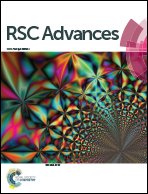Fabrication of Au/CNT hollow fiber membrane for 4-nitrophenol reduction
Abstract
Catalytic membranes have an extensive range of desirable applications in chemical fields. Here, an Au-coated carbon nanotube (Au/CNT) hollow fiber membrane was fabricated by depositing Au nanoparticles on a CNT hollow fiber membrane. The Au/CNT hollow fiber membrane exhibited excellent catalytic activity for the reduction of 4-nitrophenol to 4-aminophenol. The observed improvement in the catalytic activity can be ascribed to the synergistic effect between the Au nanoparticles and CNT membrane. The Au/CNT hollow fiber membrane described in this paper presented high stability in the 4-nitrophenol reduction process. This study offers a new avenue for the exploration of membranes for practical applications.


 Please wait while we load your content...
Please wait while we load your content...